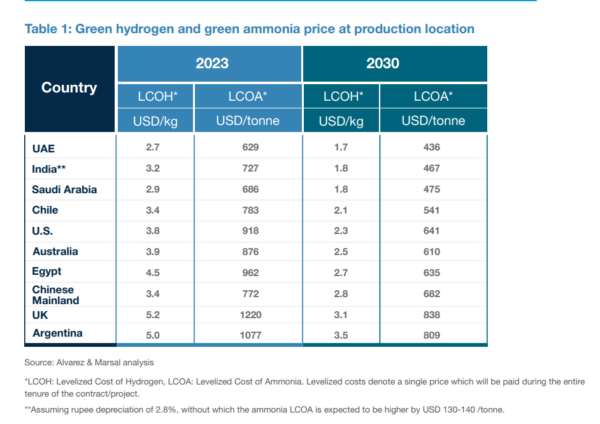UAE, Saudi Arabia, and India Lead Global Green Hydrogen Competitiveness
In the race towards a sustainable future, the global energy landscape is witnessing a paradigm shift, with renewable energy sources taking center stage. Among these, hydrogen has emerged as a promising candidate for clean energy, particularly green hydrogen produced through electrolysis powered by renewable energy.
A recent paper by business consulting firm Alvarez & Marsal has shed light on the competitive landscape of green hydrogen production, with the United Arab Emirates (UAE), Saudi Arabia, and India emerging as frontrunners in this burgeoning sector. According to the report, these countries are poised to not only meet domestic demands but also carve out a significant share of the global green hydrogen market.
The UAE leads the pack with the world's lowest levelized cost of hydrogen (LCoH) at $2.7/kg in 2023, projected to decrease to $1.7/kg by 2030. Following closely behind are Saudi Arabia and India, with production costs ranging from $2.9/kg to $3.2/kg in 2023, and projected to plummet to $1.8/kg by 2030. Moreover, the UAE also boasts the lowest levelized cost of ammonia (LCOA) worldwide, further solidifying its position in the green hydrogen arena.
The competitiveness of these nations in green hydrogen production hinges on several factors, including abundant renewable energy resources, robust manufacturing capabilities, favorable electricity ecosystems, and accessible capital. India, in particular, has recognized the potential of green hydrogen and has embarked on ambitious initiatives such as the National Green Hydrogen Mission, backed by substantial financial allocations and incentives for hydrogen production and electrolyzer manufacturing.
To capitalize on this momentum, the report emphasizes the need for India to scale up its efforts. Recommendations include creating substantial demand for green hydrogen, mitigating project risks, streamlining transactions, and executing plans with agility. By doing so, India could not only secure a larger share of the global energy trade but also reduce dependence on imports, boost GDP growth, and foster a thriving green economy.
Looking ahead, the prospects for hydrogen trade are promising, with global low-carbon hydrogen trade projected to reach $24–36 billion by 2030. Major players across the globe, including Chile, Argentina, Australia, Egypt, Saudi Arabia, and the UAE, are gearing up to capitalize on this growing market, with potential importers such as the EU, Japan, and South Korea eagerly awaiting green hydrogen exports.
While hydrogen usage is already prevalent in various sectors, the transition to green hydrogen marks a significant step towards decarbonization. By harnessing renewable energy sources and leveraging technological advancements, countries can not only reduce carbon emissions but also usher in a new era of sustainable development.
In conclusion, the UAE, Saudi Arabia, and India stand at the forefront of green hydrogen competitiveness, poised to shape the future of global energy. Through strategic investments, collaborative efforts, and policy interventions, these nations can pave the way for a cleaner, greener, and more sustainable world.







Comments
Post a Comment